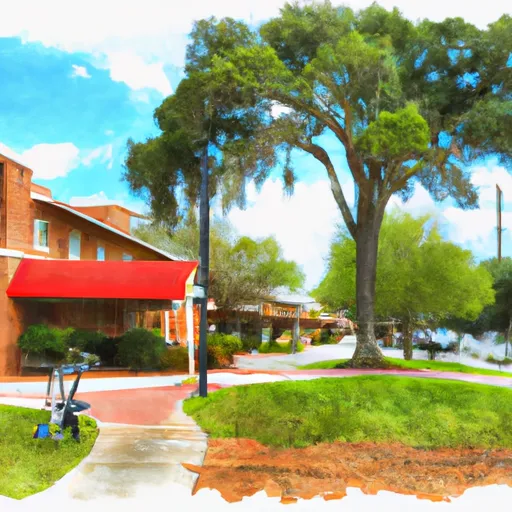-
 Snoflo Premium
Snoflo Premium
Get unlimited access to all our content
With no Ad interruptions! - Start Your Free Trial Login with existing account
Middleburg
Eden Index
Climate
7.5
•
Recreation
4.8
•
Community
2.7
•
Safeguard
5.3/10

Middleburg, Florida is a charming town located in Clay County, about 30 miles southwest of Jacksonville. The climate of Middleburg is typically characterized as humid subtropical, with hot and humid summers and mild winters. Summers experience temperatures ranging from the mid-80s to low 90s, while winters tend to be mild with temperatures in the 50s and 60s.
The hydrology of Middleburg is influenced by the presence of Black Creek, a tributary of the St. Johns River. This river system provides the town with various water-based recreational activities such as fishing, boating, and kayaking. Black Creek offers opportunities to explore the beautiful surrounding natural landscapes and observe local wildlife.
Additionally, Middleburg is home to several parks and preserves, including the Jennings State Forest. This forest covers over 24,000 acres and offers a multitude of outdoor activities like hiking, camping, and horseback riding. Other recreational opportunities in Middleburg include golfing at the various golf courses, exploring local trails, and enjoying picnics in the town's well-maintained parks.
Overall, Middleburg, Florida provides a pleasant climate, abundant hydrological features, and a range of outdoor recreation opportunities for residents and visitors alike.
What is the Eden Index?
The Snoflo Eden Index serves as a comprehensive rating system for regions, evaluating their desirability through a holistic assessment of climate health, outdoor recreation opportunities, and natural disaster risk, acknowledging the profound impact of these factors on livability and well-being.
Climate Health Indicator (CHI): 7.5
Middleburg receives approximately
1332mm of rain per year,
with humidity levels near 88%
and air temperatures averaging around
21°C.
Middleburg has a plant hardyness factor of
9, meaning
plants and agriculture in this region tend to thrive here all year round.
By considering the ideal temperature range, reliable water supplies, clean air, and stable seasonal rain or snowpacks, the Climate Health Indicator (CHI) underscores the significance of a healthy climate as the foundation for quality living.
A healthy climate is paramount for ensuring a high quality of life and livability in a region, fostering both physical well-being and environmental harmony. This can be characterized by ideal temperatures, reliable access to water supplies, clean air, and consistent seasonal rain or snowpacks.
Weather Forecast
Streamflow Conditions
St. Johns
Area Rivers
St. Johns
Snowpack Depths
St. Johns
Reservoir Storage Capacity
St. Johns
Groundwater Levels
Recreational Opportunity Index (ROI): 4.8
The Recreational Opportunity Index (ROI) recognizes the value of outdoor recreational options, such as parks, hiking trails, camping sites, and fishing spots, while acknowledging that climate plays a pivotal role in ensuring the comfort and consistency of these experiences.
Access to outdoor recreational opportunities, encompassing activities such as parks, hiking, camping, and fishing, is crucial for overall well-being, and the climate plays a pivotal role in enabling and enhancing these experiences, ensuring that individuals can engage in nature-based activities comfortably and consistently.
Camping Areas
| Campground | Campsites | Reservations | Toilets | Showers | Elevation |
|---|---|---|---|---|---|
| Salt Springs | 267 | 26 ft | |||
| Hopkins Prairie | 21 | 35 ft | |||
| Lake Griffin State Rec Area | None | 85 ft | |||
| Silver River State Park | 59 | 63 ft | |||
| Shanty Pond Recreation Area | 120 | 34 ft | |||
| Santos Rec Area State Park | 24 | 74 ft | |||
| Gores Landing County Park | None | 31 ft | |||
| Big Bass | 34 | 69 ft | |||
| Fore Lake | 100 | 82 ft | |||
| Big Scrub | 50 | 145 ft |
Catastrophe Safeguard Index (CSI):
The Catastrophe Safeguard Index (CSI) recognizes that natural disaster risk, encompassing floods, fires, hurricanes, and tornadoes, can drastically affect safety and the overall appeal of an area.
The level of natural disaster risk in a region significantly affects safety and the overall livability, with climate change amplifying these risks by potentially increasing the frequency and intensity of events like floods, fires, hurricanes, and tornadoes, thereby posing substantial challenges to community resilience and well-being.
Community Resilience Indicator (CRI): 2.7
The Community Resilience Indicator (CRI) recognizes that education, healthcare, and socioeconomics are crucial to the well-being of a region. The CRI acknowledges the profound impact of these elements on residents' overall quality of life. By evaluating educational resources, healthcare accessibility, and economic inclusivity, the index captures the essential aspects that contribute to a thriving community, fostering resident satisfaction, equity, and social cohesion.

